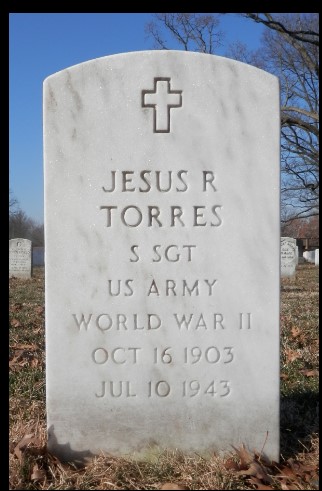BIRTH: 16 OCT 1903, Caguas, Puerto Rico, USA
DEATH: 10 JUL 1943, Sicilia, Italy
Purple Heart – 1942
Purple Heart – 1943
Army Good Conduct Medal – 1931
Army Good Conduct Medal – 1934
Army Good Conduct Medal – 1938
Army Good Conduct Medal – 1941
Army Good Conduct Medal – 1944
American Defense Service Medal – 1944
American Campaign Medal – 1944
Europe/African/Middle Eastern Campaign – 1944
World War II Victory Medal – 1944
Assignments
1923-1927, 1st Battalion, 42nd Infantry Regiment
1927-1943, 26th Infantry
1942-1943, 1st Infantry Division
Skills
Torres – One Overseas Service Bar
Torres – Six Service Stripes
Torres – Combat Infantryman 1st Award
Torres – 1st Infantry Division
Torres – 26th Maneuver Enhancement Brigade
Battles
1942-1942 WWII – Africa Theater of Operations/Algeria-French Morocco Campaign (1942)/Operation Torch
1942-1942 WWII – Africa Theater of Operations/Tunisia Campaign (1942-43)
1943-1943 WWII – European Theater of Operations/Sicily Campaign (1943)/Operation Husky
Current Situation
STAFF SERGEANT Jesus R. Torres, USA, (ASN E- 6084701) was Killed in Action on July 10, 1943 due to enemy fire. He was assigned to the 26th Infantry Regiment, 1st Infantry Division, during the Invasion of Sicily at the time of his death.

SSgt Jesus Rodriguez Torres, USA, was born on October 16, 1903, in Caguas, Puerto Rico, to Juan Torres (1883-1978), an industrial worker, and Francisca Rodriguez (1883-1929), a homemaker. He had two sisters, Luisa (1895-1995) and Ysaias (Delgado) (1910-1972).
Not much is known about his childhood and early adulthood, but the 1910 US Census indicates that he lived with his maternal grandmother in Rio Canas, Caguas, Puerto Rico. Census records also show that he only completed the 5th grade.
Based on troop ship manifests, Jesus enlisted in US Army probably as early as 1923 as part of the Puerto Rican detachment of the 42nd Infantry Regiment. He was stationed in Puerto Rico and the Panama Canal Zone. He was based in Camp Gillard in Cristobal City, Panama, from 8 November 1923 to March 1927, before returning to San Juan, PR. On April 18, 1927, the Army inactivated the 42nd Infantry Regiment and Private Torres was then re-assigned to Company D at Plattsburgh Barracks, Clinton, New York, the home of the 26th Infantry Regiment. His new regiment was under the Pennsylvania National Guard’s 28th Infantry Division (“Keystone’) called the “Iron First ” division in WWI.
On October 17, 1929, in Caguas, PR, Jesus married Tomasa Velez Rivera Y Figueroa (1909-1990) from Naguabo, PR. Their marriage certificate showed his occupation as a soldier. Soon after, he brought Tomasa to Plattsburgh and they had four children, Daisy Carmen (Arroyo/Martin) (1933-2020), John Richard (1934-2012), Robert Nelson (1936-2011), and Sigfredo (1940-). The 1940 US Census showed the Torres family living at 100 Elizabeth Street, Plattsburgh City.
On November 2, 1941, Jesus re-enlisted, and, after WWII began, he flew back to San Juan, PR, in May 1942 to what appears to be his final opportunity to see his parents before shipping overseas. Soon after, he was re-assigned to the Headquarters Company, 1st Battalion of the 26th Infantry Regiment. The Regiment became part of the 1st Infantry Division (famously known as the “Big Red One” for their shoulder patch design) and would participate in the first-ever amphibious assault in North Africa called Operation Torch (8-16 November 1942).
Using 107,000 troops and 850 ships, the Allies were organized into three amphibious task forces to simultaneously seize the key ports and airports in Morocco and Algeria, targeting Casablanca, Oran, and Algiers. Successful completion of these operations was to be followed by an eastward advance into Tunisia. On October 22, 1942, the 1st Infantry Division sailed from the United Kingdom as part of the Central Task Force assigned to attack Oran, Algeria. On November 8th, the assault began and by the next day Oran had surrendered after bombardment by British battleships. Casualties were light compared to the other two Task Forces.
Months later, Jesus found himself part of the 1st Battalion, 26th Infantry Regimental Combat Team, and in the middle of the Battle at the Kasserine Pass (19-24 February 1943) in which the Germans capitalized on the US troops’ inexperience to outmaneuver and almost wipe the Americans out. Jesus had received his first combat injury during this period and was awarded his first Purple Heart (General Order #1, PH #91477) on March 1, 1943. In the end, the Allies were able to successful defeat the German Afrika Corps and conclude the North African Campaign in May 1943.
By the time SSgt Torres had recovered from his wounds, the 26th Infantry Regiment had been chosen as one of amphibious assault units to invade the island of Sicily (09 July-17 August 1943), code-named Operation Husky. The objective was to force Germany to disperse its forces and possibly knock Italy out of the war and move Turkey to join the Allies which was considered a neutral country to this point.
Operation Husky began before dawn on July 10, 1943, with combined air and sea landings involving 150,000 troops, 3,000 ships and 4,000 aircraft, all directed at the southern shores of the island. The main scheme of maneuver would be an amphibious assault of Sicily by two Allied armies, a British landing on the southeastern coast near Syracuse and two American landings on the central southern coast at Licata and Gela. Embarking and sailing from Tunisia on troop ships, Gela would be the objective of the 1st Infantry Division. The invasion force would be facing German and Italian forces estimated at about 200,000 Italian troops, 32,000 German troops and 30,000 Luftwaffe ground staff. The main German formations were the Panzer Division Hermann Goring and the 15th Panzergrenadier Division with Tiger I and Panzer tanks.
Initial waves of landing craft hit the beaches by 03:35 in the morning. Elements of the 26th Regiment landed on the east side of the Gela River, and the 16th Regiment landed east of the 26th Regiment with Rangers taking the Gela Pier area. The 26th Regiment began moving inland to take the high ground west of Ponte Olivo. Soon, US troops encountered heavy resistance from the machine gun nests at the east end of their landing beach and artillery and mortars were targeting the beach as LCIs began landing support troops east of the Gela River.
Unexpected sand bars paralleled the beach 150 yards offshore and prevented some landing craft (including LSTs carrying tanks) from getting ashore to offload their cargo. Some soldiers landing on the sandbars in darkness drowned wading toward the beach with their heavy packs. Landing craft had to wait up to four hours to be unloaded due to air attacks and artillery fire; and a shortage of landing craft developed as nearly 200 were disabled by shellfire or broaching in the surf.
After sunrise, minesweepers began clearing mines near the beach so the LSTs could start landing vehicles at 8 am. Mine detectors were unreliable after exposure to salt water during the landing, and the first path through the minefield was not cleared until noon. By noon, not a single piece of Allied artillery had been landed, and none of the ten tanks assigned to the 1st Division were ashore.
The Battle for Gela became a real dogfight with German and Italian Divisions converging on Gela. However, in the end, the 1st Infantry Division and its subordinate elements, with naval gunfire and air support, were successful in pushing back Axis forces. This led to the capture of Sicily by mid-August and the Mediterranean sea lanes finally opened for Allied merchant ships for the first time since 1941.
Unfortunately, there were no records found as to when or where SSgt Torres was killed on that first day of the invasion and one of the 2,811 American soldiers who were killed in Sicily. He was buried in a temporary grave overseas and then initially interned in the Long Island (NY) National Military Cemetery (William Tryall) in Farmingdale, NY, on November 29, 1948, probably due to his family’s New York domicile. Finally, on September 22, 1989, he was re-interned at Arlington National Cemetery.
SSGT Torres was awarded his second Purple Heart, the Combat Action Ribbon, the American Campaign Medal, the Europe/African/Middle Eastern Campaign Medal, the World War II Victory Medal, and several Army Good Conduct Medals with twenty years of military service, and other awards posthumously.
Thank you for your service SSGT Jesus Torres.
This information was provided by togetherweserve.com

Leave a comment